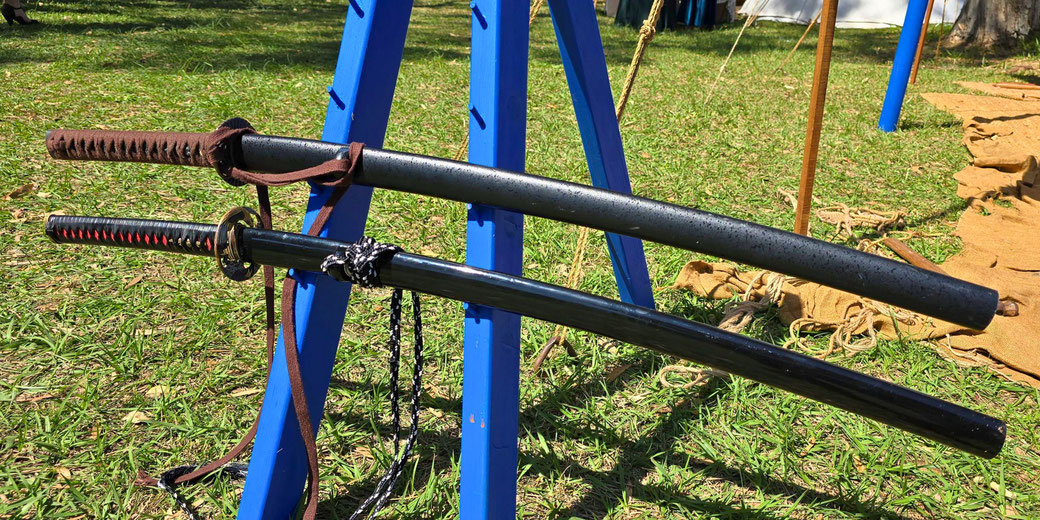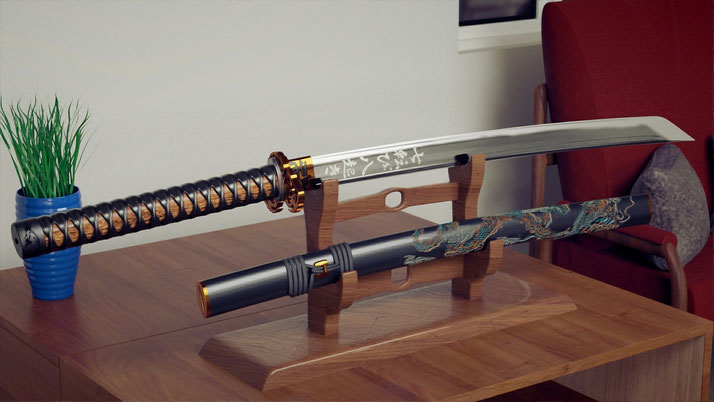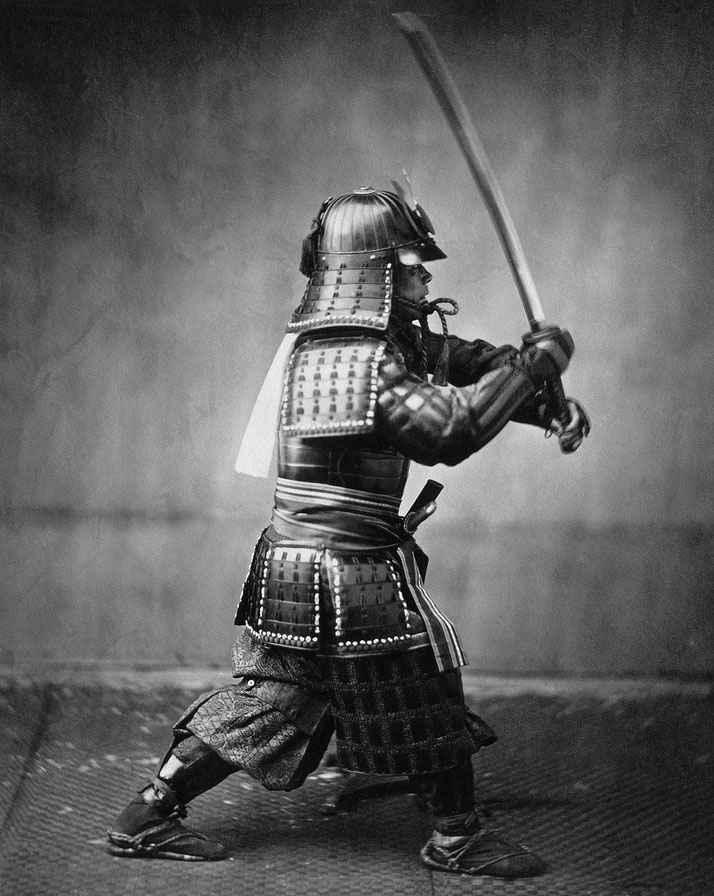Soul of the samurai: The craft and combat of Japan's legendary katana swords

The katana, the legendary sword of the samurai, the noble warriors of feudal Japan, embodies a powerful convergence of artistry, craftsmanship, and functionality.
More than a tool of war, the katana represents an object of spiritual significance and a testament to the philosophical depth of martial arts culture in Japan.
The katana's enduring appeal lies not only in its sharp edge or its remarkable durability but also in the mystique it carries, a result of centuries-old traditions and tales of the warrior class.
Unraveling its story, we enter a world where blacksmiths are artists, where a weapon is also a spiritual artifact, and where the line between practical tool and cultural symbol becomes beautifully blurred.
History of the Japanese katana
The katana's origins can be traced back to the Heian period (794 to 1185 AD), a time of cultural flourishing and political transition in Japan.
The predecessor of the katana, the tachi, was then the weapon of choice among samurai, the military nobility.
As mounted combat became more prevalent, the design of the tachi, with its more pronounced curve and edge facing downwards when worn, became popular.
However, as the nature of warfare shifted from open field combat to more close-quarters battles during the late Heian period, the need for a more versatile, easily drawn weapon became apparent.
The katana was a unique creation, marking a departure from the earlier tachi. Its main characteristics - a single-edged, curved blade with a circular or squared guard and long grip to accommodate two hands - made it an effective weapon for both cutting and thrusting.
The blade was worn with the cutting edge facing upwards, allowing a samurai to draw and strike the enemy in one fluid motion, a practice that became central to the martial arts discipline known as Iaido.

More than its functionality in combat, the katana also held a significant place in Japanese society.
To the samurai, their sword was a symbol of duty, honor, and personal pride. So revered were these weapons that they were often given names and considered part of the warrior's soul.
This respect was not limited to the battlefield; even in times of peace, the samurai were required by law to carry their swords, further solidifying the katana's status as an iconic symbol of social hierarchy and power.
The katana's importance extended into spiritual and philosophical realms as well. Bushido, the samurai code of conduct, considered the katana as a physical representation of the warrior's inner qualities - a blend of discipline, moral integrity, and an unfaltering readiness to face death.
Zen Buddhism, which influenced many samurai, related the swift, decisive action of a katana strike to the immediacy of enlightenment, thus giving the weapon an added layer of metaphysical significance.
The design of a katana
The design of the katana is a study in balance, blending form and function into a harmonious whole.
Crafted meticulously to meet the demands of battle, it was more than just a weapon; it was a work of art, an object of reverence, and a symbol of a samurai's honor.
The katana typically features a blade length of around 60-80 cm, and its gently curving shape is designed to facilitate smooth, efficient cutting strokes.
It is single-edged, allowing the back of the blade (mune) to be made thicker and more robust while the cutting edge (ha) can be razor-sharp.
The curvature of the katana also makes it a highly effective weapon for both the slashing moves common to mounted warfare and the thrusting moves necessary for on-foot combat.
The heart of the katana lies in its unique material composition. The traditional steel used for katana making is known as tamahagane, a type of Japanese steel produced from iron sand and charcoal in a clay tatara furnace.
This process yields a steel that contains varying carbon content, creating a mixture of harder, brittle steel and softer, more malleable steel.
This composition is vital to the katana's design as the combination of different steels allows the sword to possess both sharpness and durability.
A distinct feature of the katana is the wavy line or "hamon" along the blade. The hamon is a visual indication of the differential heat treatment process, or "yaki-ire," during which the blade is coated with layers of clay before being heated and rapidly cooled.
This process gives the blade's edge superior hardness while leaving the body and spine of the blade tougher and more flexible, a characteristic combination that provides both cutting power and shock absorption.
Finally, the katana's elegance is evident in its hilt, or tsuka, and its scabbard, or saya.
The tsuka is usually wrapped in ray or shark skin and then bound with silk or cotton cord for a secure grip, and it is long enough to be held with both hands, offering greater control during combat.
The saya, on the other hand, is often made of lacquered wood and can be as simple or as ornate as the owner wishes.
How to make a katana
The making of a katana is a sacred process, a ceremonial act steeped in tradition and refined over centuries.
It goes beyond simple metalwork; it is a highly specialized craft, deeply rooted in the cultural and spiritual beliefs of Japan.
Each sword is a product of countless hours of labor and a testament to the singular devotion of its creator.
The process begins with the creation of tamahagane, the raw steel used for the blade.
The steel is produced in a tatara, a traditional Japanese smelting furnace, from a mixture of iron sand and charcoal.
This is a painstaking process, meticulously controlled and usually conducted over three days and nights without interruption.
Once the tamahagane is ready, the swordsmith starts the intricate process of folding and forging.
The steel is repeatedly heated, hammered, and folded upon itself, a process that serves multiple purposes.
It helps to distribute the carbon content evenly, which is vital for the structural integrity of the blade.
Moreover, the repeated folding creates thousands of layers within the steel, giving the blade its distinctive pattern and enhancing its strength.
After the blade has been shaped and its edge defined, it undergoes the crucial process of heat treatment known as yaki-ire.
This involves the application of a clay slurry to the blade, with a thicker layer applied to the body and spine of the sword, and a thinner layer along the edge.
The sword is then heated and quickly quenched in water. This differential cooling creates two distinct zones within the blade: a hard, sharp edge, and a softer, more resilient spine.
Once the heat treatment is complete, the blade is sent to be polished. This is not merely an aesthetic step; the polishing of a katana can take as long as the forging process itself.
The polisher, known as a togishi, uses a series of progressively finer stones to refine the blade.
This process brings out the beauty of the hamon and the grain pattern of the folded steel, while ensuring that the edge of the sword is razor sharp.
The crafting of the katana concludes with the creation and assembly of the hilt, guard, and scabbard.
These elements are often made by other specialized craftsmen, who might add intricate carvings, gold inlay, or other details to the sword fittings.
Each of these components is a work of art in itself, further enhancing the beauty and status of the finished katana.
Creating a katana is an art that requires patience, dedication, and a deep understanding of the materials and processes involved.
Each sword is a unique product of its maker's skills and knowledge, embodying a tradition that stretches back centuries.
How to fight with a katana in battle
A katana is more than just a weapon; it is a tool through which samurai expressed their martial prowess, tactical acumen, and philosophical understanding.
Over centuries, intricate techniques for wielding the katana have been honed and perfected, forming a critical part of the samurai's arsenal.
These techniques cover a range of movements, each suited to a different situation on the battlefield and revealing the katana's versatility.
In terms of combat usage, the katana was designed for both cutting and thrusting. The curvature of the blade facilitated an effective draw-and-cut technique, wherein the samurai could unsheath the sword and strike in one swift, fluid movement.
This ability was crucial on the battlefield, where the difference between life and death could hinge on the speed of a single stroke.

Kenjutsu, the art of the sword, became a cornerstone of samurai training, providing warriors with the skills needed to wield their katanas with precision and lethality.
This martial art involves a range of techniques, including strikes, parries, and counterattacks, as well as learning how to handle the sword in both offensive and defensive situations.
Kenjutsu schools proliferated during the feudal era, each with its unique style and techniques, but all focused on maximizing the katana's potential in combat.
Alongside Kenjutsu, the art of Iaido emerged, emphasizing the smooth, quick drawing of the sword, striking an opponent, removing blood from the blade, and then replacing the sword in the scabbard.
Iaido is as much a spiritual and philosophical practice as it is a physical one, with practitioners seeking to align their mind, body, and spirit through the perfection of these movements.
With the transition from feudal society to a more peaceful era, the martial art of Kendo arose, translating the skills of Kenjutsu into a form suitable for competitive sport and personal development.
In Kendo, practitioners use bamboo swords and protective armor to engage in bouts that test not only their physical skills but also their discipline, strategic thinking, and mental resilience.
The spiritual ceremonies to care for a katana
Owning a katana is not just about wielding it in battle or practice; it also involves preserving the blade's quality and longevity through careful maintenance and care.
Proper care of a katana is essential to prevent damage such as rusting, dulling of the blade, or degradation of the handle and scabbard.
This commitment to maintaining the weapon reflects the high regard in which the katana was held, as a tool, a weapon, and a work of art.
After each use, a katana should be cleaned to remove any residue or moisture that could potentially corrode the blade.
The traditional method of cleaning involves a kit known as a Mekugi-nuki, which includes rice paper for removing oil and dirt, a special oil (Choji oil) for blade preservation, a powder ball (Uchiko) for polishing, and a container to store old cloths.
The process requires delicate handling to avoid damaging the blade's finely polished surface or causing personal injury.
Beyond regular cleaning, the katana also requires periodic inspections to check for signs of damage, such as rust spots, nicks, or loose fittings.
Any serious concerns should be addressed by a professional, as attempting to repair a blade without the proper knowledge and skills can lead to irreversible damage.
Another critical aspect of katana care involves proper storage. A katana should be stored horizontally, with the edge facing upwards to prevent undue pressure on the edge, and in a dry, cool place to avoid moisture buildup that could lead to rusting.
The sheath, or Saya, protects the blade when it's not in use, but care should be taken not to store a katana in its sheath for extended periods in a humid environment, as this could trap moisture and cause rust.
When it comes to transport, the katana should always be carried in a protective case, ideally one specifically designed for swords.
This prevents any accidental damage and makes handling the sword safer and more manageable.
The practice of maintaining a katana is a ritual in itself, requiring patience, attention to detail, and respect for the weapon.
The samurai saw it as a necessary and honorable duty, reflecting their broader ethos of discipline and respect.
How katana-making was perfected over time
During the Kamakura period (1185–1333), widely considered the golden age of sword making, the katana was perfected as a weapon for the samurai class.
This era produced some of the most revered swordsmiths in history, such as Masamune and Gō Yoshihiro, who created blades renowned for their exceptional quality and beauty.
The Muromachi period (1336–1573) saw the introduction of mass production techniques in response to the demands of large-scale warfare.
This led to changes in the design of the katana, with blades becoming shorter, wider, and more curved to suit the new combat style of this era.
During the Edo period (1603–1868), a time of relative peace, the katana's role shifted more towards a symbol of status rather than a tool of war.
This change in context encouraged more ornate and sophisticated designs, with emphasis on artistic qualities and intricate detailing.
Swordsmiths developed innovative techniques and styles, enhancing the aesthetics of the katana while maintaining its form and function.
The late 19th century brought an end to the samurai era, and the katana, as an icon of that class, fell out of use.
The Meiji Restoration of 1868 banned the carrying of swords in public, leading to a decline in traditional sword making.
However, interest in the katana did not completely wane; it was kept alive through martial arts and the dedication of a small number of traditional swordsmiths.
In the 20th century, the art of the katana experienced a revival, both in Japan and abroad.
The Japanese government recognized traditional sword smithing as an intangible cultural heritage, providing support for the craft and encouraging its continuation.
Today, the katana represents a link to Japan's past, a symbol of its cultural identity, and an embodiment of its traditional craftsmanship. Modern swordsmiths continue to strive for perfection, just as their ancestors did centuries ago.
What do you need help with?
Download ready-to-use digital learning resources
Copyright © History Skills 2014-2025.
Contact via email
With the exception of links to external sites, some historical sources and extracts from specific publications, all content on this website is copyrighted by History Skills. This content may not be copied, republished or redistributed without written permission from the website creator. Please use the Contact page to obtain relevant permission.





